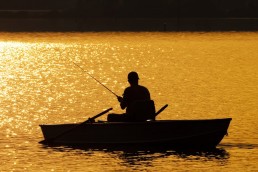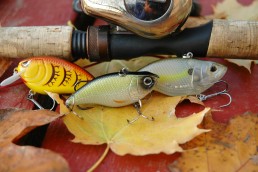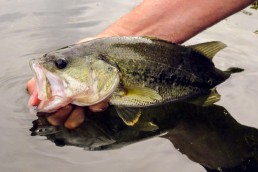Basic Bass Rigs to Know and Use Next Season
SHARE THIS POST
As you are looking at ways to improve your bassin’ next season, or if a family member is just getting hooked on bassin’, here are three key rigs that every bass angler uses at some point during the fishing season. From largemouths to smallmouths, these rigs can play a key role on any body of water.
Texas-rig
The first rig is the Texas-rig. From weedless rigging to extreme versatility, the Texas-rig is likely on the deck or in the rod locker of any top-level tournament bass angler.
A Texas-rig consists of three components: a weight, hook and a soft plastic bait. By changing up the bait and weight, you can do many things with it.
By upping your weight to a 1/2-ounce or heavier tungsten weight, you can probe deep-water cover, or punch through the thickest mats of vegetation. Or, by using a very small split shot or 1/16-ounce tungsten weight, you can let your plastic bait drift in current, or swim it over the top of vegetation.
The vast array of soft plastic baits on the market make great options for Texas-rigging; from tubes to craws to lizards and worms, there is a shape, size and color that will work for your favorite body of water. Importantly, you need to select a hook size and style that fits both the style and size of the plastic body. This ensures that you get the right action out of the bait, along with a solid hook-up ratio on bass.
With a Texas-rig, you can target any form of fish-holding cover. From pitching it to weed clumps or edges, or around stumps and laydowns, it is a must-know rig for any bass fisherman.
I like using a Zoom Z-Craw rigged weedless on an Eagle Claw Lazer TroKar TK133 Pro V Ben Flippin’ Hook (4/0), teamed with a 7/16-ounce tungsten weight. I can flip this combo around shallow-water cover and under boat docks, cast it to weed lines or drag it over underwater structure.
Carolina rig
A Carolina-rig is a great for targeting deep-water structure that is holding bass. An C-Rig, as it is commonly referred to, is also a great way to determine bottom content, and the type of structure available on the bottom of the lake.
C-Rigs shine around underwater humps, wood, points and breaks, and effectively cover a vast amount of water in a short amount of time. By adapting the components to your local body of water, you can employ this technique nearly everywhere from deep lakes to shallow rivers.
Are you enjoying this post?
You can be among the first to get the latest info on where to go, what to use and how to use it!
The components of a Carolina-rig consist of a weight and beads threaded onto your main line, followed by a barrel swivel. This swivel then connects a fluorocarbon leader to a Texas-rigged worm. Many seasoned riggers prefer using s heavy tungsten or brass weight; when it comes in contact with the beads between the weight and swivel, the noise is quite loud in the water. The leader can range in length from 12 inches up to 36 inches, depending on the water clarity and bass position in the water column. On the business end of the leader is the hook and soft plastic bait; like the Texas-rig, the bait options are endless, and the hook used should correlate to the bulk of the plastic bait.
I prefer using a Zoom Lizard rigged on a 3/0 Eagle Claw Lazer TroKar TK120 Magworm Wide Gap Hook, a 1/2-ounce brass weight, with an 18-inch leader of 15-pound-test Seaguar TATSU. This setup allows me to both target deep underwater structure and drag it over mid-depth flats.
Drop shot rig
A newer technique that inexperienced bass anglers often neglect is the drop shot rig. Many may view drop shotting as a finesse deep- or clear-water presentation. While it undoubtedly shines in these circumstances, anglers can employ a drop shot in stained, shallow water as well.
The drop shot works in a variety of situations, from fishing it early in the year on bedded bass, to dropping it directly under the boat to bass holding on isolated deep-water structure, to pitching it into holes in weed lines. In all cases, the drop shot is versatile and effective in presenting a more streamlined and finesse-oriented soft plastic profile to bass.
To rig a drop shot, tie Palomar knot to your hook, leaving 12 to 16 inches of extra line on the tag end of the knot. Then, instead of cutting the tag end of the knot off, run it back through the hook eye, creating a dropper line. Then clip a drop shot weight onto the tag line, anywhere you want your dropper to end. Fished vertically, the sinker will tap bottom, while the worm wiggles and jiggles a set distance above, visible to bass.
For weight selection, I try to use the smallest weight possible, which depends on the water depth and wind. The length of your dropper will be dictated by the water depth and density of cover you are fishing, along with how bass are related to the bottom.
Plastic bait choices can vary based on the cover you are fishing, along with the forage the bass are keying on. If they are feeding on minnows, then I want my bait to resemble a minnow. If the bass are very lethargic, then I’ll use a small, thin, flexible plastic bait such as a 4-inch worm, to make any bass curious despite tough conditions.
I like using a Zoom Fluke Stick Jr. rigged on a 1/0 Eagle Claw Lazer TroKar TK127 Finesse Hook, teamed with a 3/16- or 3/8-ounce tungsten cylinder drop shot weight. I’ll use the smaller-sized weight when fishing along the edge of cover, and turn to the heavier weight when pitching the drop shot rig into the cover, or into open-water pockets inside it.
With these three simple-to-rig bass fishing setups, you’ll be able to effectively target bass on any body of water, regardless of depth, cover or time of year.
MWO
SHARE THIS POST
Did you enjoy this post?
You can be among the first to get the latest info on where to go, what to use and how to use it!
Glenn Walker
Glenn Walker has been fishing Minnesota and Mississippi River tournaments for more than 15 years, spreading his passion and knowledge of the sport via articles and videos. For more information, check out glennwalkerfishing.com or on Facebook @GlennWalkerFishing.



